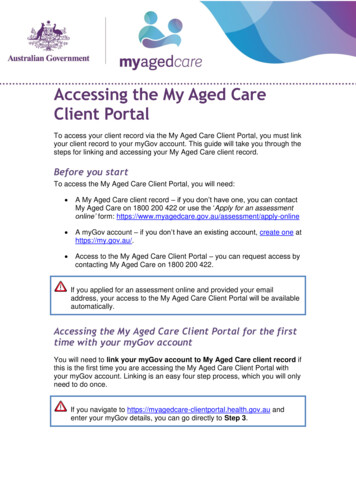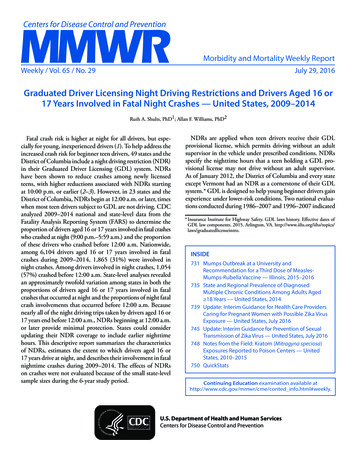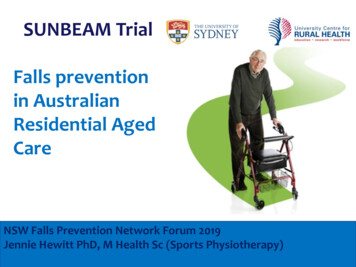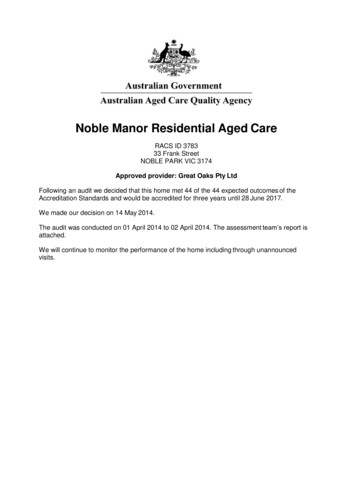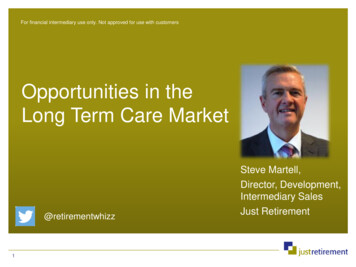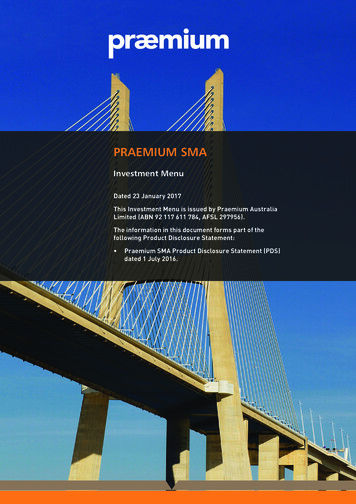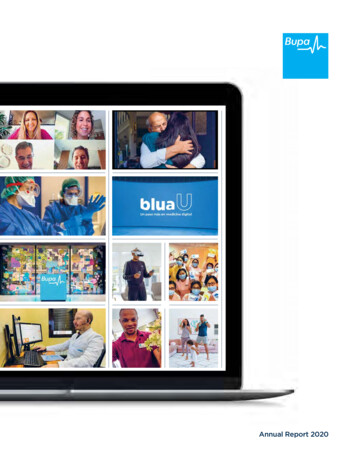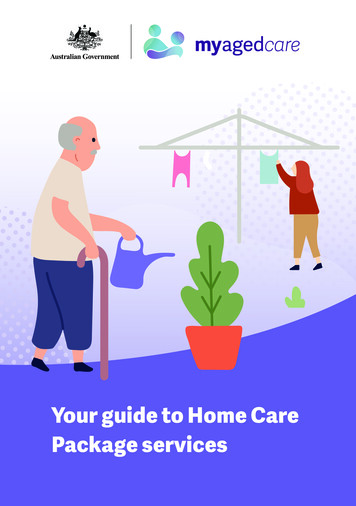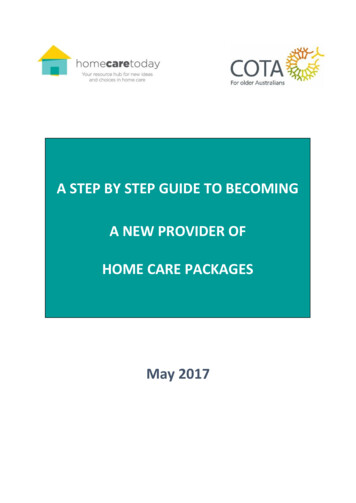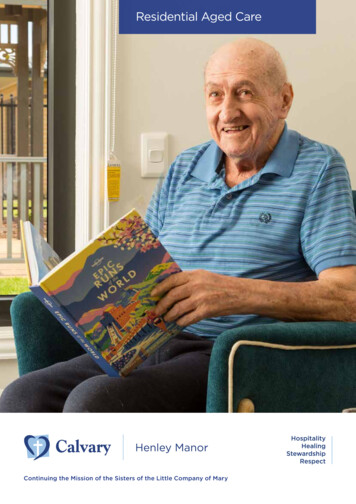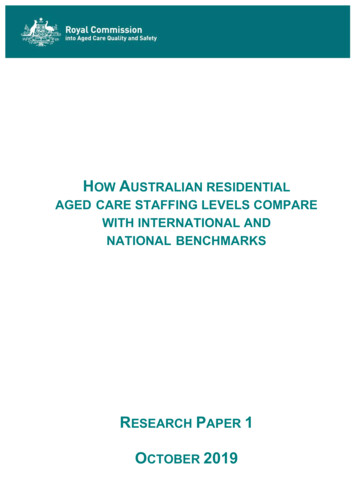
Transcription
HOW AUSTRALIAN RESIDENTIALAGED CARE STAFFING LEVELS COMPAREWITH INTERNATIONAL ANDNATIONAL BENCHMARKSRESEARCH PAPER 1OCTOBER 2019
The Royal Commission into Aged Care Quality and Safety was established byLetters Patent on 8 October 2018. Replacement Letters Patent were issued on6 December 2018, and amended on 13 September 2019.The Honourable Richard Tracey AM RFD QC, the Honourable Tony Pagone QCand Ms Lynelle Briggs AO have been appointed as Royal Commissioners.They are required to provide an interim report by 31 October 2019, and a finalreport by 12 November 2020.The Royal Commission intends to release consultation, research and backgroundpapers. This research paper has been prepared by the University of Wollongongfor the information of Commissioners and the public. The views expressed in thispaper are not necessarily the views of the Commissioners.This paper was published on 11 October 2019. Commonwealth of Australia 2019ISBN 978-1-920838-85-0 (online)With the exception of the Coat of Arms and where otherwisestated, all material presented in this publication is providedunder a Creative Commons Attribution 4.0 International licence.For the avoidance of doubt, this means this licence only appliesto material as set out in this document.The details of the relevant licence conditions are available onthe Creative Commons website as is the full legal code for theCC BY 4.0 licence www.creativecommons.org/licenses .The terms under which the Coat of Arms can be used are detailedon the Department of the Prime Minister and Cabinet website www.dpmc.gov.au/government/commonwealth-coat-arms .
How Australian residential aged carestaffing levels compare withinternational and national benchmarksA research study commissioned by the RoyalCommission into Aged Care Quality and SafetySeptember 2019
Kathy EagarAnita WesteraMilena SnoekConrad KobelCarol LoggieRob GordonThis paper has been prepared by the University of Wollongong for the information of theRoyal Commission into Aged Care Quality and Safety and the public. The views expressed inthis paper are not necessarily the views of the Commissioners.Suggested citationEagar K, Westera A, Snoek M, Kobel C, Loggie C and Gordon R (2019) How Australianresidential aged care staffing levels compare with international and national benchmarks.Centre for Health Service Development, Australian Health Services Research Institute,University of Wollongong.
ContentsKey findings . 11Introduction. 31.1The changing policy context . 31.2Australian residential aged care profile . 41.2.1Funding . 41.2.2Staffing . 51.3231.3.1International evidence . 61.3.2Australian evidence . 71.4The role of casemix . 81.5Recent developments . 9Methods . 112.1Search strategies . 112.2Data sources . 11International Review . 133.14Relationship between staffing levels and quality. 6Review findings . 133.1.1International frameworks . 133.1.2Australian frameworks . 143.1.3Exclusions from further analysis . 14Modelling international and national frameworks . 174.1United States of America . 174.1.1Modelling Approach . 194.1.2Results . 204.2Canada – British Columbia. 234.2.1Modelling Approach . 244.2.2Results . 244.3Germany . 254.3.1Modelling Approach . 274.3.2Results . 284.4Australia . 294.4.1Victoria . 294.4.2Queensland . 315Discussion and conclusion . 336References . 36How Australian residential aged care staffing levels compare with international and national benchmarks
List of tablesTable 1Full-time equivalent (FTE) direct care employees in residential aged care . 5Table 2Summary of review findings . 13Table 3CMS staff cut points: minutes per resident day . 18Table 4CMS Staff levels and Rating . 19Table 5Australian staffing roles and CMS staffing star rating . 19Table 6Distribution of Australian residents of CMS star rating for staffing domain . 22Table 7Average increase in staff time per resident day required to improve rating . 22Table 8Care time shift as result of improvements of care in lower rated facilities . 23Table 9Australian staffing roles mapped to British Columbian aged care roles . 24Table 10Average increase in staff time per resident day to meet British Columbianrequirements. 25Table 11Overall care time shift as result of improvements to meet British Columbianrequirements. 25Table 12Number of residents per care staff FTE . 26Table 13Average FTE care staff levels per 100 residents in German states. 27Table 14Australian staffing roles mapped to aged care roles in Germany . 28Table 15Average increase in staff time per resident day to meet German requirements . 29Table 16Overall care time shift as result of meeting the German requirements . 29Table 17Australian staffing roles mapped to Victorian public aged care roles. 30Table 18Average increase in staff time per resident day to meet Victorian requirements. 31Table 19Overall care time shift as result of meeting the Victorian requirements. 31Table 20Australian staffing roles mapped to Queensland public aged care roles . 31Table 21Average increase in staff time per resident day to meet Queensland requirements 32Table 22Care time shift as result of improvements to meet Queensland requirements . 32FiguresFigure 1Comparison of CMS star rating for staffing domain (combined rating) . 21Figure 2Comparison of CMS star rating for staffing domain (RN rating) . 21Figure 3Australian residents whose care achieves British Columbian recommendations. 25Figure 4Proportion of Australian residents whose care meets each German regulation . 28Figure 5Proportion of Australian facilities whose care meets the Victorian standard . 30Figure 6Proportion of Australian residents whose care meets the Queensland standard . 32How Australian residential aged care staffing levels compare with international and national benchmarks
Key findings This report reviews the national and international staffing requirements for residential agedcare services. There are two broad approaches to determining staffing requirements: (1) mandatedminimum levels and (2) specification of ‘appropriate’ (not minimum) levels. Debate regarding staffing levels in aged care homes is premised on evidence in healthservices where a direct relationship between nursing staff mix and quality of care has beenestablished. As with health care, quality in aged care is impacted not only by staffing levels.It is also driven by organisational culture, skill mix and consistency in staffing personnel. The research in this report draws on the data collected during the Resource Utilisation andClassification Study (RUCS) that underpins the Australian National Aged Care Classification(AN-ACC). It provides representative results for residents in Australian aged care homes. A key finding in this study is that, among comparable countries, the USA Centers forMedicare and Medicaid Services (CMS) Nursing Home Compare system employs the mostcomprehensive approach to staffing levels. This is the best system currently availableinternationally to evaluate existing Australian staffing levels. Further, it provides a usefulmodel that could be progressively refined and adapted in Australia to inform future staffingrequirements. This report also includes an overview of systems employed in British Columbia (Canada),Germany and the Victorian and Queensland public residential aged care services. Details arediscussed in the body of the report (pages 17 - 32). The CMS system uses a 5 star rating to define adequacy of care staffing levels in residentialaged care services, with ratings adjusted to take account of differences between homes interms of the complexity of their resident’s care needs (‘casemix adjustment’). Refining theUSA model to make it suitable for use in Australia, our judgement is that:o 1 or 2 stars represent unacceptable levels of staffingo 3 stars is acceptableo 4 stars is good, ando 5 stars is best practice. More than half of all Australian aged care residents (57.6%) are in homes that have 1 or 2star staffing levels. Of the remaining 42.4% of residents, 27.0% are in homes that have 3 stars, 14.1% receive 4stars and 1.3% are in homes with 5 stars. To raise the standard such that all residents receive at least a 3 star level of staffing:o Requires an average increase of 37.3% in total care staffing in those aged carehomes currently rated 1 or 2 star.o Will result in an overall increase of 20% in total care staffing across Australia. To raise the standard such that all residents receive at least a 4 star level of staffing requiresan overall increase of 37.2% in total care staffing.How Australian residential aged care staffing levels compare with international and national benchmarks1
To raise the standard such that all residents receive 5 star level of staffing requires anoverall increase of 49.4% in total care staffing. A weakness of the CMS model is that it does not address allied health staffing levels.However, if adapted and refined for use in Australia, it could be developed to do so. The staffing model in place in British Columbia Canada is one system that does include alliedhealth staffing levels. Only 2% of Australian residents are in homes that current meet the 22minutes of allied health services per day recommended in the British Columbia system. Thecurrent Australian average is 8 minutes of allied health care per day. Achieving the levelrecommended in British Columbia would require a 175% increase in allied health staffing. These additional resources do not take into account any increases required to address theviability of the sector. They also do not take account of any salary increases required toimprove attraction and retention rates and/or improve the skill mix of staff. The results presented in this report apply to the sector as a whole. At the level of anindividual home, staffing levels should reflect the needs of residents. Only a system thatadjusts for the mix of residents (a ‘casemix’ system) can provide meaningful information toinform the staff numbers and skill mix required in each facility. The current residential aged care funding measure, the Aged Care Funding Instrument(ACFI) is not a casemix system and does not sufficiently discriminate between levels ofneed. Accordingly, it does not provide a basis on which to determine appropriate staffinglevels. The Australian National Aged Care Classification (AN-ACC) is a casemix classification thatwill, if fully implemented, facilitate the meaningful determination of staffing requirementsacross classes and allow for the systematic measurement and benchmarking of qualitywithin the sector.How Australian residential aged care staffing levels compare with international and national benchmarks2
1IntroductionThe Centre for Health Service Development, part of the Australian Health Services ResearchInstitute (AHSRI) at the University of Wollongong, was commissioned by the Royal Commissioninto Aged Care Quality and Safety (the Commission) to undertake this analysis of internationaland national staffing profiles for residential aged care services in order to better understandhow staffing can be improved in Australia. The key activities for the project include a literaturereview on international and national models of staffing in residential aged care facilities anduse of data from the Resource Utilisation and Classification Study (RUCS) (Eagar et al. 2019) tocompare Australian practices to the standards of those models. This analysis will alsocontribute to a better understanding of the costs involved in delivering higher quality carethrough effective staffing levels in residential aged care facilities.The concept of quality residential aged care has changed considerably in recent years as caremodels have moved from institutional to person-centred principles of practice andorganisational quality measures shift from a focus on inputs and outputs to outcomes forresidents. A recurring theme in the evidence presented to the Commission has been that thestaffing levels and skill mix within aged care has been insufficient to support quality outcomesfor residents.There is strong evidence from the health sector about the relationship between staff levels andskill mix to quality of care and safety of clients (Australian Commission on Safety and Quality inHealth Care 2019). This is not the case for the aged care sector, due to a combination of datalimitations as well as organisational and cultural factors (OECD/European Commission 2013a).This report draws on data collected as part of the RUCS project which was undertaken by theAustralian Health Services Research Institute (AHSRI), University of Wollongong in 2017-18 andwhich underpinned the development of the proposed new casemix funding model for agedcare, the Australian National Aged Care Classification (AN-ACC) (Eagar et al. 2019). The RUCSincluded independent assessments of approximately 5,000 aged care residents, thestandardised collection of operational and staffing costs associated with 140 homes acrossAustralia, and the collection of service utilisation data from around 1,600 care staff across 30care homes. We are confident that these data are representative of the broader Australianresidential aged care sector. 11.1 The changing policy contextThe aged care sector has evolved in recent decades in response to challenges associated withdemographic trends, resourcing constraints and consumer expectations. The introduction ofthe Aged Care Act 1997 (the Act) sought to reframe the role of residential aged care services asbeing people’s ‘homes’ and to move away from the institutionalised model of care thatpreviously dominated the sector. The Act also included provisions to underpin the expansion ofcommunity aged care services to allow older people to stay living in their own homes longerwhich, in turn, has resulted in people having much higher levels and/or complexity of need bythe time they enter residential aged care.The sampling framework for the RUCS study data included in this report is detailed in RUCS Report 3: Structuraland individual costs of residential aged care services in Australia available e 1975&context ahsri#page 31How Australian residential aged care staffing levels compare with international and national benchmarks3
The re-conceptualisation of residential aged care as a ‘home’ has inadvertently encouraged thedevelopment of a workforce that is less clinically skilled and oriented with greater reliance onlower skilled personal care workers. Similarly, there has been limited incentive for eithergovernment or the sector to invest in systems that routinely capture and monitor residentneeds or outcomes over time.These changes were embedded further with the 2011 Productivity Commission (PC) report‘Caring for Older Australians’ and the subsequent ‘Living Longer Living Better’ aged carereforms of 2012. The PC report argued that the sector needed to offer ‘greater continuity ofcare and empower older people to exercise greater choice’ through consumers having access toinformation regarding services, including staffing levels, costs and quality of care provided(Productivity Commission 2011).It also recommended the establishment of an Australian Aged Care Commission to consider‘the appropriate mix of skills and staffing levels’ for aged care services. However, theGovernment did not adopt this recommendation. This did not include advocating mandatorystaffing ratios which, it argued, were ‘unlikely to be an efficient way to improve the quality ofcare’ (Productivity Commission 2011, p. 206).The convergence of these trends has resulted in a residential aged care sector that ischallenged by the need to support residents with higher and more complex care needs, whoseusers and advocates have greater expectations regarding service standards, and a staff profilethat has been increasingly de-skilled over time. Not surprisingly, there have been continuingclaims regarding increased workloads for staff, particularly registered nurses, and concernsregarding compromised quality of care for residents (Mavromaras et al. 2017, p. 166),(Australian Nursing and Midwifery Federation 2019).These are echoed in the submissions of consumer stakeholders to the numerous inquiries andreviews into aged care of recent years, particularly in regard to the care needs associated withaged care residents living with dementia who have responsive behaviours, also referred to asbehavioural and psychological symptoms of dementia (BPSD). 21.2 Australian residential aged care profileResponsibility for the regulation, policy development and funding of aged care services restswith the Australian Government through the administration of the Act by the Department ofHealth (Council of Australian Governments 2011). Aged care organisations delivering servicesfunded by the Department are expected to have ‘a workforce that is sufficient, and is skilledand qualified, to provide safe, respectful and quality care and services’ (Standard 7, Aged CareAccreditation Standards, Australian Government Department of Health 2019).1.2.1 FundingA total of 12.3 billion in funding was provided for residential aged care in 2017-18, of which 10.8 billion (87.8%) was delivered under the Aged Care Funding Instrument (ACFI) fundingmodel for personal and nursing care services for permanent residents (Aged Care Financing2For example, see Dementia Australia https://www.dementia.org.au/submissionsHow Australian residential aged care staffing levels compare with international and national benchmarks4
Authority 2019, p. 101). In general, ACFI funding is directly translated into staffing costs ofpersonal care assistants (PCAs), Assistants in Nursing (AINs), Enrolled Nurses (ENs) andRegistered Nurses (RNs). With 180,923 permanent residents in aged care homes at 30 June2018, this equates to approximately 163.73 per resident day (Aged Care Financing Authority2019, p. 82).1.2.2 StaffingThe Department of Health does not mandate minimum staffing levels for residential aged care.Rather, as noted above, the Aged Care Quality Standards require all aged care services to havea sufficient, skilled and qualified workforce. This was not previously the case. Prior to 2014 agedcare places were allocated on the basis of ‘high’ and ‘low’ care places according to populationbased planning ratios. At this time there was a requirement for a RN to be on duty at all timesfor residents living in high care facilities. The removal of the distinction between high and lowcare also resulted in a more generalised requirements regarding staffing in the Standards.The Australian Government does not routinely capture staffing data but monitors it through theNational Aged Care Workforce Census and Survey conducted every four years by the NationalInstitute of Labour Studies. The 2016 survey showed the national average ratio of direct careworkers to operational places was 0.78, with jurisdictional differences ranging from 0.66(Northern Territory) and 0.69 (NSW) to a high of 0.91 (SA and ACT) (Mavromaras et al. 2017Table 4.4).Overall, there has been a reduction in the proportion of direct care employees in the totalresidential aged care workforce since the first survey was undertaken, from 74% in 2003 to 65%in 2016 (Mavromaras et al. 2017, p. 12). There has also been a decline in full-time equivalentqualified nursing and allied health staff, with a reduction in RNs from 21% in 2003 to 14.6% in2016, ENs from 14.4% to 9.3% and allied health from 7.6% to 4% during the same period. Thesepositions have been replaced by PCAs whose representation has increased from 56.5%(n 42,293) of the workforce to 71.5% (n 69,983) (Table 1) (Aged Care Financing Authority2019).Table 1Full-time equivalent (FTE) direct care employees in residential aged ed nurse16,26513,24713,93914,564Enrolled nurse10,9459,85610,9999,126Personal care %Nurse practitionerAllied health professionalAllied health assistantTotal number of employees (FTE)As a % of total employeesNurse practitionerHow Australian residential aged care staffing levels compare with international and national benchmarks5
Occupation2003200720122016Registered nurse21.4%16.8%14.7%14.9%Enrolled nurse14.4%12.5%11.6%9.3%Personal care .9%Allied health professionalAllied health assistant1.3 Relationship between staffing levels and qualityThe evidence on the relationship between staffing and quality in residential aged care lags farbehind that of the health care sector. A clear relationship between hospital inputs andoutcomes (patients receive safer care, have less adverse events and achieve better clinicaloutcomes) has been established and routine processes are in place to record and monitoroutcomes over time.Methodological, definitional and cultural challenges within aged care have limited its capacityto routinely measure quality. One stated reason is that care homes provide clinical as well associal support to residents whose functional status and autonomy are declining over time(OECD/European Commission 2013a, p. 16). As such, the measures of quality to date haveprimarily focused on relationships between inputs (dollars, staff numbers) and outputs (clientnumbers, incident rates) rather than client outcomes (quality of care).1.3.1 International evidenceThe OECD long-term care quality framework describes staffing as being pivotal to quality agedcare. It identifies three core domains for quality aged care: safety and effectiveness; personcentred and responsiveness; and care co-ordination. These domains are underpinned by threekey ‘structural inputs’: workforce (including staffing); environment; and information andcommunication technology (ICT) systems (OECD/European Commission 2013a, p. 48).The OECD framework was developed following a comprehensive review of quality measures inaged care including consideration of the role of staffing levels and mix. It identified a range ofworkforce attributes that directly contributed to quality aged care, including staffing ratios perresident, consistency of caregiving staff, staff turnover, length of employment, education andtraining, and staff response times. However, the review found very few examples of countriesthat systematically collected indicators relating to these attributes.Two of the earliest and most comprehensive studies were undertaken on behalf of the Centersfor Medicare and Medicaid Services (CMS) in the United States, titled The Appropriateness ofMinimum Nurse Staffing Ratios in Nursing Homes Phase I and Phase II studies (Abt AssociatesInc. 2001). The Phase I study found ‘a strong relationship between staffing and quality andconcluded that there may be critical ratios of nurses to residents below which nursing homeresidents are at substantially increased risk of quality problems’ (Institute of Medicine (U.S.)2001, p. 192). Phase II explored the issue in more detail, addressing the questions of whetherthere was a ‘ratio of nurses to residents below which nursing home residents are atHow Australian residential aged care staffing levels compare with international and national benchmarks6
substantially increased risk of quality problems’ and conversely, a ratio ‘above which noadditional improvements in quality are observed?’The Phase II study confirmed a series of specified staffing levels required to meet therecommended government standards. In 2001 the minimum staffing level was 4.1 hours (246minutes) per resident day of direct care, comprising 0.75 hours (45 minutes) of RN time, 0.55hours (33 minutes) of Licensed Practice Nurses (LPNs – equivalent to Enrolled Nurse inAustralia) and 2.8 hours (168 minutes) of Certified Nursing Assistants (CNAs – equivalent topersonal care attendants). These were found to be the staffing levels beyond which point therewas no evidence of improved quality outcomes for residents.The Phase II study concluded that 97% of nursing homes would fail to meet one or more of thequality standards and 52 percent of all nursing homes would fail to meet all of these standards.This latter group would be at substantially increased risk of experiencing quality problems(Feuerberg 2001, p. 5). Thus, only 3% of nursing homes at that time would meet all of thethresholds and be allocated five stars under the staffing element of the CMS Nursing HomeCompare system.A 2011 systematic review concluded ‘there is little evidence for the effective use of any specificmodel of care in residential aged care to benefit either residents or care staff’ (Hodgkinson etal. 2011). More recently, however, a review of over 150 studies that had been documented insystematic reviews of nursing home staffing levels, primarily from the US, Canada, UK andnorthern Europe, confirmed a ‘strong positive impact of nurse staffing on both care process andoutcome measures’ (Harrington et al. 2016). The review found several studies that highlightedthe contribution of organisational factors to care quality, such as having a high professionalstaff mix (ratios of RN to total staffing levels), low staff turnover rates and use of agency staff,and consistency in staffing.Several studies have highlighted the changing needs and expectations of residents that areimpacting on staffing attributes and skill levels. The expansion of home care servicesinternationally has resulted in people entering residential aged care with greater complexity ofcare needs, and at the same time ‘demanding greater flexibility, more choice, more autonom
Institute (AHSRI) at the University of Wollongong , was commissioned by the Royal Commission into Aged Care Quality and Safety (the Commission) to undertake this analysis of international and national staffing profiles for residential aged care services in order to better understand how staffing can be improved in Australia.
